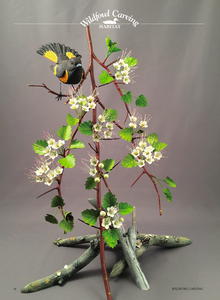Make Your Habitat Blossom
How to create a hawthorn branch for your bird

Tom Park began woodcarving when he retired in 1997 after 38 years as a teacher and principal. He is a member of the board and co-chair of Prairie Canada Carvers Association. He frequently offers courses in carving songbirds, shorebirds, and raptors and does multiday workshops in habitat design and construction. You can contact Tom at tpark@mymts.net.
Small blossoms such as apple, plum, or hawthorn can add another dimension to your habitat and your carving. And the good news is that they are easy to make with some basic equipment. If you have a butane torch with pencil flame, a small soldering iron, and a few simple holding devices, you can handle this project. It doesn’t hurt to have a fair bit of patience, too, as you will discover when you start adding anywhere from 10 to 20 stamens to a single blossom. However, you can avoid that by choosing a blossom with a simpler structure.
The many North American hawthorns include native, non-native, and hybrid varieties, and they have differences (sometimes subtle) in the blossoms, leaves, and branches. For this demonstration, I will focus on the common hawthorn. It’s easy to find near my home, so I could carefully study it. Just like with birds, you need to observe the real thing if you want to get it right. The blossoms I am copying are cup-shaped with five petals and numerous, relatively long stamens. While the blossoms live a fairly long time, I still found it necessary to take lots of photos as they would eventually wilt.
You must be careful that your habitat doesn’t overpower the subject of the carving. I wanted to have a number of blossom, bud, and leaf clusters but didn’t want them to detract from the bird. It seemed important to select a bird the blossoms would complement and not overpower. I settled on the American redstart (Setophaga ruticilla). This is arguably one of the busiest of the warblers. Warblers are sometimes referred to as “the butterflies of the bird world,” and the American redstart fits this description better than most as it flits from branch to branch in search of food while flashing its brilliant coloring. The male redstart is coal black on the wings, tail, back, and breast, with white belly and flanks. But its most startling features are the orange patches on each side of the tail and on the wings and breast. The redstart often fans its tail and drops or raises its wings as it moves about looking for insects, perhaps to startle its prey and make it easier to catch. Whatever the motivation, it’s a gorgeous display by one of nature’s most attractive little gems. I considered it unlikely that any blossoms could overpower this bird. (For American redstart painting notes, see the Winter 2016 issue.)
Branches normally grow upward from the main trunk of the tree as they reach for light, but some of the small, slender branches droop downward, especially toward the end of the branch. This is the look I decided to capture.
This article is from the Fall 2016 issue. For more information on our issues, check out our issues page.
Read NextCarve a Peregrine Falcon Head



